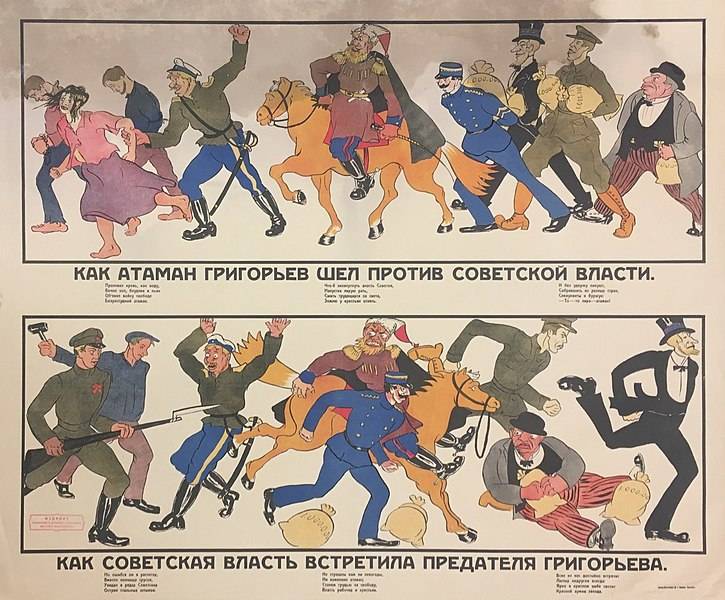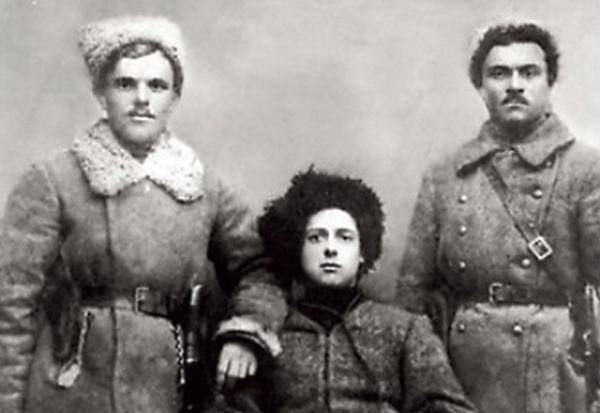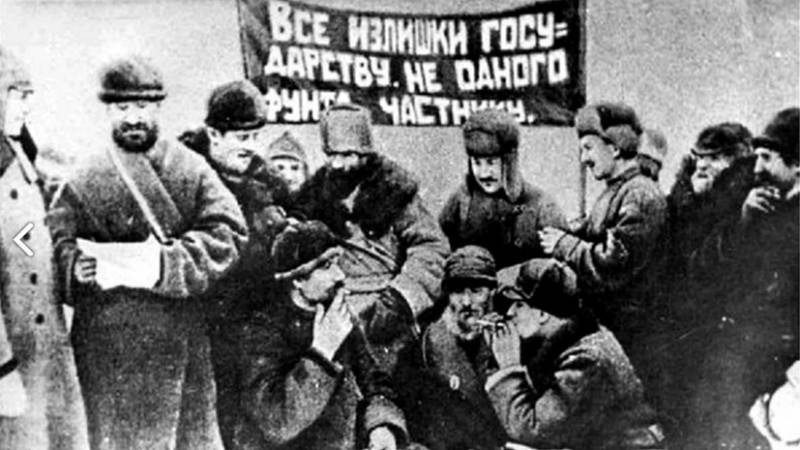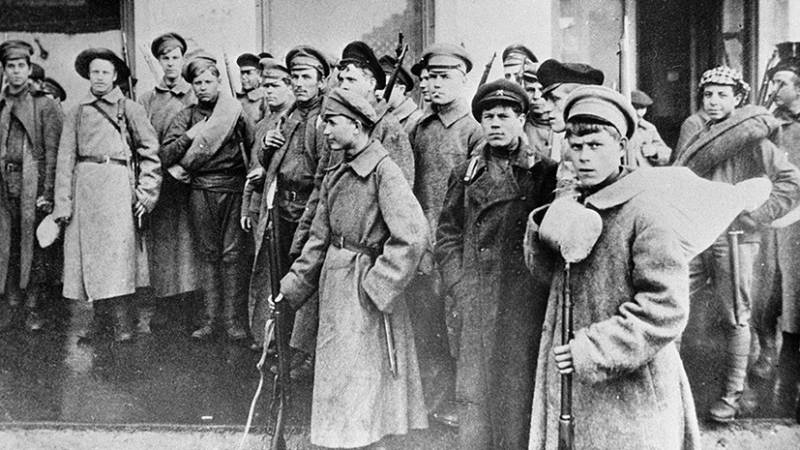Uprising in the Ukraine. How failed the “Blitzkrieg” of Grigorievka

Peasant War in Little Russia
7 May 1919, the 3 Red Army, which included Grigoriev's division, was ordered to launch an operation to free Bessarabia and help Soviet Hungary. The Antonov-Ovseenko Commander Front ordered the 6 Division to be concentrated on the Dniester River, near the Romanian border. The commander himself visited atman Grigoriev in his “headquarters” in Alexandria. Antonov-Ovseenko again persuaded the ataman to start a campaign in Europe, predicted to him "the glory of Suvorov." The Red Command offered Grigoriev and another plan - to oppose the White Cossacks on the Don Front. Grigoriev again dodged, spoke about the need to rest the troops, but eventually agreed to speak "to the Romanians."
Antonov-Ovseenko, realizing the danger of a radical food policy in areas where peasant rebels previously dominated, flooded with a large number of weapons, reported to the government of Soviet Ukraine that the actions of the food detachments provoke the peasants to revolt and offered to withdraw the "Moscow" food detachments from Little Russia. However, the Ukrainian government could not curtail food policy without the consent of Moscow. As a result, in May 1919, the outrage of the peasants of Little Russia and New Russia with the Bolsheviks' food policy reached its peak. A large number of food detachments from the central regions of Russia arrived in Small Russia. They acted uncontrollably, often selected the latter. And the peasants were already robbed by the German occupiers and the regime of Hetman war. District congresses of Soviets demanded the abolition of such a food policy and expulsion of visitors from Little Russia, but they were not listened to. Revolutionary committees and committees of the poor headed by the Communists, who did not enjoy the support of the majority, were implanted in the villages. The Bolsheviks tried to collectivize as soon as possible. The peasants did not want to give the former landlords, for which they have already paid a high price. Thus, a new stage of the peasant war in Little Russia began.
The situation was complicated not only by the fact that, returning to their places of origin, the Grigor'evs were confronted with the pro-detachments and security officers who were in charge there, but also the soldiers of the 6 division found themselves in the neighborhood with a powerful insurgent movement directed against the Bolsheviks. In April, 1919, a wave of uprisings swept through Kiev, Chernihiv and Poltava provinces. Thus, a major uprising under the leadership of Ataman Zeleny began in March 1919 in the south of the Kiev province, in Tripoli.
Danilo Terpilo (Green is a nickname) had a life path similar to Grigoriev. A member of the Social Revolutionary Party, a revolutionary, was exiled to the North of Russia for revolutionary activities. Released in 1913, on the occasion of the amnesty for the 300 anniversary of the Romanov dynasty. The participant of the First World War, after the revolution, the participant of the Ukrainianization of the army, the organizer of "free Cossacks". He supported the Central Council, fought against the Hetman and the German occupiers. In November, 1918 of the year formed the 1 th Dnieper rebel division, participated in the uprising against the Skoropadsky regime and in the siege of Kiev. A good speaker and organizer, the division commander Terpilo actually became the head of the independent “Dnieper Republic”, which included several districts of the Kyiv region. Enters into conflict with Petliura, not wanting to go to war with the Poles. In January, 1919, the uprising is already against the regime of the Directory, Petliura, and goes over to the Reds. Forms 1 th Kiev Soviet division. Then he comes into conflict with the Bolsheviks when they re-form and “clean” the Green detachments. In March, 1919 raises uprising in Tripoli. The uprising of Green was supported by local peasants embittered by the policy of "war communism." Green diverted the considerable forces of the Red Army and was finally defeated only in June 1919.
Ataman Zeleny declared himself an “Square Bolshevik”, advanced the slogan “Soviets without Communists”, demanded to curb the absolute power of the Cheka and local party organizations, cancel the development and forced collectivization, create an independent Ukrainian army and an independent Soviet Ukraine. At the same time, the “Square Bolshevik” opposed the local kulaks, which was in the interests of the bulk of the peasantry. Green's program was popular, his "army" in April numbered 6 thousand fighters and threatened with the siege of Kiev. By May, the number of troops had increased even more - to 8 thousand people, Terpilo was the owner of the region of Tripolye - Obukhov - Rzhishchev - Pereyaslav. Ataman announced the creation of an army of independent Soviet Ukraine and had the support of other rebel leaders Struk, Satan and Angel.
The uprising of the Green forced the Red Command to send significant forces against it and the Dnieper Military flotilla. By May 8, 1919, the Zeleny rebel army was defeated and driven out of the base area. His troops were dispersed, divided into small detachments and groups. The revolt of the Green became one of the factors that prompted the revolt and Grigoriev. Hoping to support the “greens,” Grigoriev hoped to quickly capture the south of the Kiev region, but he miscalculated that by the beginning of his advance the “army” of Zeleny was already dispersed.

The beginning of the uprising Grigorievtsy
In early May 1919, the revolt of the Grigoryevites began, at first it was spontaneous. 1 May Grigoryevites fired on Elizavetgrad from guns of an armored train. Then the fighters of Grigoriev staged a Jewish pogrom at the Znamenka station, robbed houses, and killed dozens of people. On 4 – 6 on May Grigoryevtsy carried out pogroms in Elizavetgrad, Alexandria, at Dolinskaya stations. The bandits not only robbed and killed Jews, but also attacked the Communists, Red Army soldiers, Chekists and police officers. The government and command constantly received reports of robberies and pogroms, the insecurity and suspicion of the chieftain and his army.
However, the authorities and the commanders still hoped that these were only isolated incidents unrelated to the “red” division commander, Grigoriev. 4 May completed its work in the 6 Division of the Higher Military Inspectorate. She concluded that it was necessary to quickly dismiss Grigoriev and his staff and bring them to court. The Antonov-Ovseenko Commander’s Front chose to close its eyes to this. Only on May 7, when the scale of the “outrages” was no longer possible to hide, the commander of the 3-th Ukrainian Soviet Army Khudyakov ordered Grigoriev in 24 hours to clean up the division. If the divisional commander could not do this, he should have arrived at the headquarters of the army in Odessa and resigned his commanding authority. In the event of non-compliance with the order, Grigoriev was declared a rebel. On the same day, the Chekists of the Special Department of the Front tried to arrest Grigoriev. They broke into the carriage chieftain and declared him arrested, but were immediately disarmed by the guard of the chieftain and then shot. In the Grigorievsky division all Communists were arrested.
8 May 1919, Nikifor Grigoriev publishes Universal (manifesto) "To the people of Ukraine and the soldiers of the Red Ukrainian Army" (apparently prepared by the head of Tyutyunnik), which becomes a call for a general uprising. The document was a call for the "dictatorship of the working people" and the establishment of "people's power". Grigoriev advocated Soviet power, but without the dictatorship of an individual or party. The All-Ukrainian Congress of Soviets was to form a new government of Ukraine. At the same time, representatives of all nationalities in proportion to their number in Little Russia should have entered the Councils of all levels: Ukrainians - 80%, Jews - 5% and for all other nationalities - 15%. That is, nationalism prevailed in Grigoriev’s political program. Although there were very few “Ukrainians” in Little Russia at that time, mainly intellectuals, people involved in “politics”. The overwhelming majority of the population of Little Russia (the south-western part of Russia-Russia) were Russians, like 300, 500 or 1000 years ago.
At the same time, Grigoryev was still cunning, he wanted to deceive the red command in order to gain time for a surprise attack. Ataman telegraphes that he has nothing to do with the Universal, and promises 10 in May to go to war in Romania. The rebel promises to meet with party leader Kamenev. On 10 of May 1919 of the year, his troops - 16 thousand fighters (according to other sources - 20 thousand people), more than 50 guns, 7 armored trains and about 500 machine guns, launched an offensive. At this time, the entire Ukrainian Soviet front consisted of about 70 thousand people with 14 armored trains, 186 guns and 1050 machine guns. On the same day, Grigoryev told Commander Antonov-Ovseenko that he was beginning an uprising and would destroy everyone who came to Ukraine for the purpose of exploitation. Ataman boastfully promised two days later to take Yekaterinoslav, Kharkov, Kherson and Kiev.
Bloody mayhem
Grigorievtsy launched an offensive in several directions at once. Grigoriev hoped to join forces with Green and Makhno. A column under the command of the head of the insurgents Tyutyunnik was moving on Ekaterinoslav. A column led by the commander of the brigade Pavlov went to Kiev. In the first three days of the offensive, these units captured: Kremenchug, Chigirin, Zolotonosha, and the local Red garrisons joined the rebels. As a result, the rebels seized all available weapons, ammunition, property and valuables.
Separate detachments were sent to Odessa and Poltava. The Cossack chieftain Uvarov occupied Cherkasy, where the 2 th Soviet regiment joined the Grigorievtsy. The Gorbenko column under the command of Gorbenko, where the Verblyuzhsky regiment was the main force, captured Elizavetgrad on May 8. Grigorievtsy disarmed the red garrison, shot near the Communists 30. 15 May Elizavetgrad was a terrible Jewish pogrom. Thousands of people, including women, children and the elderly, were killed from 3 to 4. Several hundred "newcomers from the North" were brutally murdered. Grigorievtsy released criminals from prison, who joined the rebels and took an active part in the killings, robberies and pogroms. Pogroms also took place in all places occupied by the rebels, thousands of people were brutally killed in Uman, Kremenchug, Novaya Buta, Cherkasy, Alexandria, etc. In Cherkasy, the commanders ordered every fighter to kill at least 15 people. They killed not only Jews, but also communists, “newcomers from the North” (newly arrived Russians).
For a short period of time, the fire of the uprising embraced a huge region and it seemed that Grigoriev would become the owner of the central part of Little Russia, the bloody dictator of Ukraine. The rebels 10 -14 May took Uman, Novomirgorod, Korsun, Alexandria, Baltu, Ananyev, Krivoy Rog, Kobelyaki, Yagotin, Pyatikhatki, Khrestivovka, Litin, Lipovets and other settlements. Everywhere, local garrisons passed over to the side of the Grigoryevs. Pavlohrad mutiny was raised by the soldiers of the 14 th regiment of the Red Army, Kazyatine went over to the side of the ataman, the Nezhinsky regiment, the 1 th regiment of the Red Cossacks revolted in Lubny.
On Yekaterinoslav's direction, on May 11, Verkhnedneprovsk garrison joined the rebels. The headquarters of the 2 th Soviet army fled from Yekaterinoslav. To organize the defense of the city failed. May 12 in Yekaterinoslav revolted the Black Sea regiment of the sailor Orlov and the cavalry anarchist Maxyuta. They went over to the side of Grigoriev, destroyed the prison and staged a pogrom. May 15 Red Parkhomenko troops recaptured Yekaterinoslav. Every tenth rebel was shot, including Maxyut. On May 16, prisoners of Grigorievsk revolted, united with criminals, crushed the prison, and again captured the city.
Thus, the situation was extremely dangerous. There was a threat that other Soviet troops would go over to Grigoriev’s side. Began preparations for the evacuation of Kiev, Poltava and Odessa. It seemed that the rebels were supported by the peasants of the central part of the Ukraine, and part of the Red Army soldiers, mostly of local origin.
15 May began an uprising in Belaya Tserkov, 16 May was revolted by sailors of Ochakov. In Kherson, the power was re-elected by the reelected executive committee of the Soviets headed by the left Socialist-Revolutionaries, who supported Grigoriev. They were supported by the local garrison - the 2 th regiment and the regiment to them. Doroshenko. Kherson for two weeks became an “independent Soviet republic”, which fought against the Bolsheviks. May 20 rebels occupied Vinnitsa and Bratslav for one day. The fire of the uprising spreads to Podolia, where Grigoriev was supported by local chieftains Volynets, Orlik, and Shepel. Soldiers and sailors led by the Left Social Revolutionaries rebelled in Nikolaev. In Aleksandrovsk, the red units sent to fight Grigoriev refused to fight, dispersed the Cheka and freed the prisoners from prisons. A regiment of the 1 of the Ukrainian Soviet Army, directed against Grigoriev, rose. The rebels defeated the Bolsheviks in Berdichev and Kazyatin, and threatened Kiev.
End of Ataman
However, all this was the appearance of triumph. The base of the "army" Grigoriev was shaky. Grigorievtsy took up, until they had in front of a strong and motivated opponent. Grigoriev himself was not a great strategist and commander. He could command a regiment or brigade in a revolutionary time; this was his ceiling. He could not find allies to expand the social basis of the uprising. Grigoriev's troops, spoiled by easy victories and full power, quickly turned into gangs of criminals, sadists, robbers and murderers, which quickly alienated many rebel peasants and Red Army men. Even the peasant congress, convened by him himself in Alexandria, suggested that the troops of Grigoriev "stop the excesses". A number of the city declared "neutrality." The regiments that had previously moved to the side of the rebels began to return under the authority of the red command.
Grigoryevtsev did not support another famous chieftain, Makhno. Although his relations with the Bolsheviks were on the verge of breaking. On the proposal of the Soviet government of Ukraine to take part in the struggle against the uprising, the old man replied that he was refraining from assessing the actions of Grigoriev and would fight the white army of Denikin. His army (about 25 thousand fighters) at that time fought with the whites, advancing on Gulyai-Pole. As a result, the Old Man did not support Grigoriev’s uprising. Later, on May 18, representatives of Makhno will visit the area of the uprising and inform the Father that the Grigorievites are staging pogroms and exterminating the Jews. After that, Makhno issued an appeal “Who is Grigoriev?”, Where he called the chief ataman “robber”, “counterrevolutionary” and “pogrom-monger”. The old man himself was a fierce opponent of anti-Semitism and in his domain severely punished the mob.
Ataman could not plan a good operation. Grigoriev, having moved his main forces at once on three directions (to Yekaterinoslav, Kiev and Odessa), he sprayed his army from the Dniester and Podillia to the Dnieper, from the Black Sea coast to Kiev. Thousands of insurgent peasants, Red Army men and bandits joined his division, but they were poorly organized and had low combat capability. Therefore, Grigoriev's “lightning echelon war” exhausted already five days after the start. The uprising seized a huge region, but the rebels preferred to sit on the ground, clearing them of the Bolsheviks, or smashing the Jews and the "bourgeois". Defeat was inevitable.
The Soviet authorities and the Red Command took extraordinary measures. The parties of the Ukrainian Left Social Revolutionaries and the Ukrainian Social Democrats, who inspired the rebels, were outlawed. The Ukrainian SSR was mobilized by communists, Soviet workers, workers, Komsomol members. About 10 thousand people arrived from the central part of Russia. The People's Commissar of Internal Affairs of the Ukrainian SSR Voroshilov, taking command of the Kharkov district, headed the rout of the insurrection. On May 14, three groups of troops (about 30 thousand people) under the command of Voroshilov and Parkhomenko launched an offensive from Kiev, Poltava and Odessa.
In the very first real battles, the Grigorievtsy were completely crushed. The rioters were not able to stand under the guns and machine guns. The host of Ataman crumbled. The insurgent regiments immediately "came to their senses" and returned to the Red Army. Others were captivated or simply fled. 19 May 1919, the Yegorov group took the Kremenchug, and the Dnieper military flotilla - Cherkasy. From the south, the units of Dybenko and Parkhomenko attacked, joining with the group of Egorov, they occupied Krivoi Rog. May 21 rebels broke near Kiev, May 22 - Reds occupied the rebel capital Alexandria, May 23 - Znamenka. At the end of May, the Reds regained control of Nikolaev, Ochakov and Kherson. Captured and shot closest associates of the ataman - Gorbenko and Masenko. The remnants of the Grigorievskians are hiding in distant steppe villages and are switching to guerrilla war tactics. Chief of Staff Tyutyunnik with 2 thousand fighters makes a thousand-kilometer raid on Right-Bank Ukraine and goes over to Petlyura.
A powerful uprising was ended in two weeks! The gangsters, accustomed to being all afraid of them and all running in front of them, proud of the "victory" over the Entente, fled at the very first battles with regular Soviet units. They broke up into detachments and groups that acted and saved themselves. The beginning of the offensive of Denikin’s army and the uprising of Makhno saved the Grigorievtsy from complete destruction in May. The most combat-capable forces of the Reds were abandoned against the White Guards and the Makhnovists. The remaining red parts were decomposed and they could not crush the uprising. As a result, for some time the Grigorievtsy could have been outraged, making raids on cities, on trains that went from the Crimea and the Black Sea coast to the north, again seized a lot of different property and good.
In July, 1919, Grigoriev and Makhno entered a military alliance against whites and reds. However, the contradictions between them were too strong. The Old Man did not approve of the anti-Jewish pogroms and the political orientation of Pan Atman. Grigoriev, apparently, was ready to change the color again. He began negotiations with Denikin, noting their correct policies and the idea of convening a Constituent Assembly. Grigorievtsy at that time struggled with the red, but shied away from fighting with the whites, which irritated the dad. Makhno was the decisive enemy of the whites. Most of the Makhno commanders were against the alliance with Grigoriev, they condemned him for the pogroms. In addition, Makhno, apparently, might want to eliminate a competitor, remove the chieftain, whose presence could aggravate the situation of the father.
Therefore, the union of the Makhnovists and the Grigorievites existed for only three weeks. As a result, the Makhnovists decided to end the gangster ataman. 27 July 1919 in the village council of the village of Sentovo, the ataman Grigoriev was killed by the Makhnovists who accused him of dealing with the White Guards and pogroms. Grigoriev's guard was scattered by machine-gun fire (the Makhnovists prepared the carts in advance). Grigoriev's body was thrown into a ditch behind the village, it became the prey of feral dogs. Grigoriev’s staff members and bodyguards were removed, the ordinary soldiers were disarmed, and most of them soon joined the army.
This is how the adventurer and the “winner of the Entente”, the “head ataman” of Ukraine Grigoriev died. The bloody final, the final was logical: from the Russian imperial army to the Central Rada, from Hetman Skoropadsky to the Directory, from Petlyura to the red, from the Bolsheviks to the free atamans. Grigorieva's adventure sank in blood.
Grigoriev's uprising showed the instability of the position of the Bolsheviks and the Red Army in Little Russia, the fallacy of the course towards Ukrainization, including the stakes on the Ukrainian Soviet units. Therefore, some independence of the army of the Ukrainian SSR was eliminated. In June, the Ukrainian Soviet Military Commissariat (Ministry) and the Ukrainian Front were disbanded on 1919. The “purge” of the red command was carried out; for serious miscalculations, Antonov-Ovseenko and the member of the Revolutionary Military Council of the Front Shchadenko, the commanders of the three Ukrainian Soviet armies Macilylevsky, Skapko and Khudyakov were barred from serious miscalculations The Ukrainian Soviet armies were reorganized into three ordinary rifle divisions. The command staff was also “cleaned up”. The struggle with the Makhnovshchina began.


Information